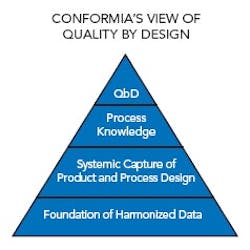April's SAP Sapphire Users' Group meeting also brought news of a partnership between SAP and Conformia, a California-based software company that specializes in product lifecycle management (PLM) solutions designed to improve data and knowledge transfer during drug development. The partnership will extend SAP's enterprise resource planning (ERP) solution to incorporate PLM, simplifying the web of IT connections typically found in the drug development environment. A leading pharmaceutical company headquartered in the midwestern U.S. is currently implementing Conformias platform.
However, Conformia has also been involved in a cooperative research and development agreement (CRADA) with FDA, which aims to pinpoint weaknesses in information transfer during drug development, both from the perspective of drug companies and FDA.
Initial findings from the first phase of the CRADA, a blinded research study called Challenges and Opportunities in Pharmaceutical Development, will be released this summer. Anjali Kataria, principal investigator on the CRADA and chief marketing officer for Conformia, recently discussed some of the obstacles preventing industry and FDA from improving the overall drug development and approval process.
Information management must be improved, the research suggests. But so must organizational thinking. In order for the industry to move to a true Quality by Design drug development model, FDA must strengthen the connection between review and inspector teams for small-molecule drugs, while senior managers within the industry must get directly involved in promoting the cross-functional culture that QbD demands.
Both CRADA partners welcome and encourage more industry participation in this important research. Pharma companies can take part in joint FDA/industry workshops on QbD. So far, three of these workshops have been held in Washington, involving over 200 participants in pharma, biotech, and generics manufacturing, some of whom had not been exposed to QbD concepts and had never applied them to FDA submissions or their internal processes.
These workshops, Kataria says, allow top managers from very different companies to discuss cross-functional implementation and specific ways to apply ICH Q8 and 9; they also offer a neutral, open venue in which FDA and the industry can communicate on issues and problems in the spirit of continuous improvement. Companies can also participate in case histories. Currently, biopharma unit operation case histories are being developed, but the CRADA will establish a chemistry manufacturing and control information management (CMC-IM) working group to analyze real-life mock submissions and apply quality systems management principles and knowledge management strategies.
Originally, nine pharma, biopharma and generics companies took part in this research, but Kataria expects the number to increase to 25 by this summer.
For more information on the CRADA and how to participate in the conferences and case studies, e-mail [email protected], or contact Conformia at 408-625-3881.




